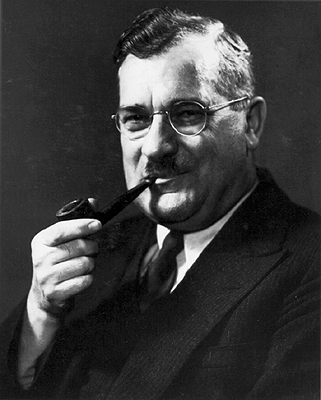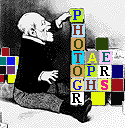

Luke Swank was born in Johnstown, PA in 1890. As a young man, Swank attended Penn State Agricultural School and went on to work as a cattle breeder, police dog trainer, and finally as a clerk in his father's hardware store. After returning from service in WWI, Swank took up work as an auto mechanic and began to tinker with a camera.
In 1930, at the age of 40, Swank took some photographs of Bethlehem Steel's millworks and sold them to his friends at the Johnstown plant. Two years later, he took his steel mill photographs to Julien Levy's art gallery in New York, where photography was then being showcased. Julien Levy recognized Swank's talent and encouraged him to continue. Soon, there was enough material to mount a one-man show at the gallery, and this exhibition would "launch" Luke Swank on his photographic career. That same year (1932), Swank contributed a 12-foot photomural of Pennsylvania steel mills to the Museum of Modern Art (MOMA) for an exhibit which focused on this new format. By 1934, Swank had exhibited in several prestigious galleries in New York and San Francisco, winning recognition and praise all along.
Also in the early 1930s, Swank photographed the University of Pittsburgh campus and caught the attention of then-Chancellor John Gabbert Bowman. The chancellor subsequently hired Swank in 1935 as the university's official photographer. From his studio in the Cathedral of Learning, Swank taught the first college-level courses in photojournalism. Swank left the university in 1937 to open his own studio in downtown Pittsburgh with financial help from department store magnate, Edgar Kaufmann. Swank's photographs of Kaufmann's house, "Fallingwater," were subsequently exhibited at MOMA. Also during this time, Swank taught a photography course at Duquesne University.
Although Swank was fascinated with the slums of Pittsburgh and the crumbling grand houses of the city's North Side, he also pursued documentation of the circus, urban life, and Pennsylvania's rural architecture. In announcing an exhibit in 1934 at New York's Delphic Studios, Luke Swank was praised by Frank Crowninshield, editor of Vanity Fair, who remarked, "Not only is Luke Swank interested in interpreting American life, but in revealing what is particular to American light and air. Therein, we believe, lies his artistry." The critic, Bruce Lockwood, also commented, "He has exalted the snapshot, which most photographers shun, into an art. Luke Swank is doing for photography what Flaubert did for the novel."
Of his peers, Luke Swank admired news photographers the most for their directness and lack of contrivances, noting, "There is no fake about their work." In addition to his teaching and exhibits, Swank sold his work to such publications as Vogue, House & Garden, Fortune, Life, and The New York Times. During the 1940s, Swank worked with the H.J. Heinz Company. His photographs were especially admired when used to illustrate Heinz Company cookbooks. He died at age 54, having enjoyed a short but wildly successful 14-year career.
Sources: Luke Swank, edited by Clyde Hare in preparation for an exhibit of Luke Swank's photographs at the Carnegie Museum of Art, February 5 through March 9, 1980; and The Bulletin Index, March 7, 1935.
In addition to Luke Swank's photographs at the Pittsburgh Photographic Library, the Carnegie Museum of Art maintains substantial holdings of his work. Modest holdings are maintained at the Art Institute of Chicago (IL), Smith College Museum of Art (MA), the George Eastman House (NY), the Museum of Modern Art (NY), and the Johnstown Flood Museum (PA).
Being Photographed
Caplan's Market
Kleban Bros.
St. Michael's
pd
